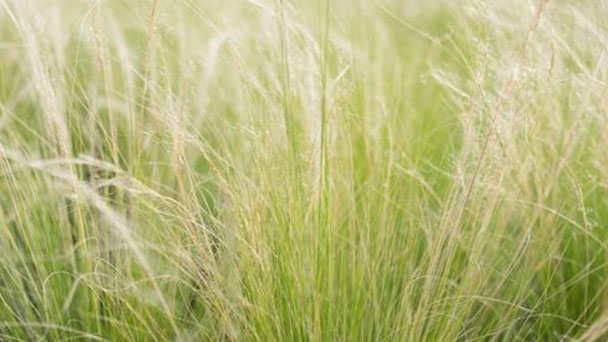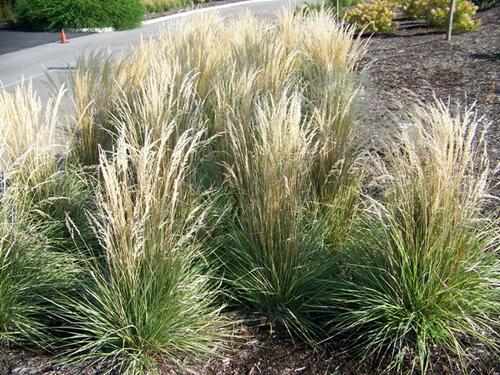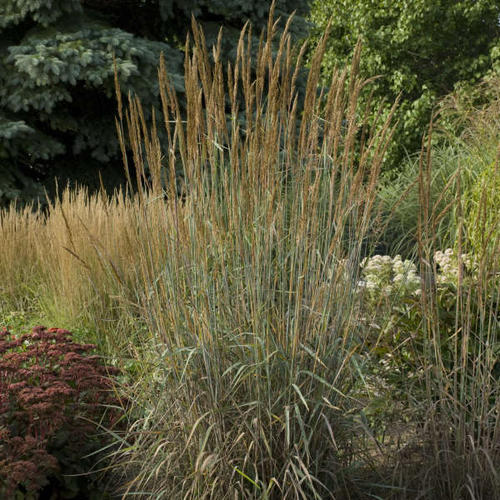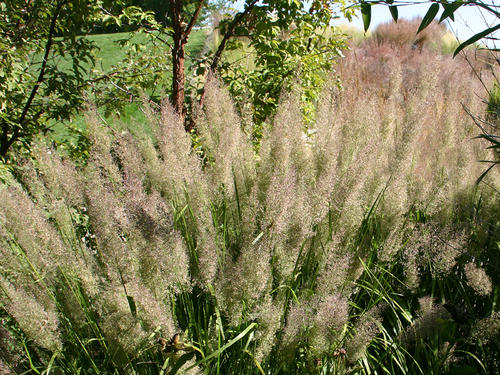Feather reed grass (Calamagrostis acutiflora) profile
Written by Maggie
Mar 29 2021

Feather reed grass grows in irrigation ditches, river embankment swamps, all over the world. The stem and root of Feather reed grass can also be used in the paper industry, as well as biological agents. The processed Feather reed grass stems can also be made into arts and crafts. Feather reed grass was used to make brooms in ancient times. Feather reed grass is one of the main plants growing in a wetland environment.
Feather reed grass has erect stalks, tall plants, swaying in the wind, wild. Because the leaves, leaf sheaths, stems, rhizomes and adventitious roots of Feather reed grass all have aerenchyma, it plays an important role in the purification of sewage. Tough stalks, high fiber content, is a rare raw material in the paper industry. It grows more along the lake.
Feather reed grass picture

Feather reed grass info
| Botanical Name | Calamagrostis x acutiflora |
| Common Names | Feather reed grass, reed grass |
| Plant Type | Perennial |
| Sun | Full sun |
| Hardiness Zones | 5–9 (USDA) |
| Flower color | Pinkish-purple |
| Native Area | Europe, Asia |
| Mature size | 3–5 ft. tall, 1.5–2.5 ft. wide |
Feather reed grass characteristics
Stems
Feather reed grass is a perennial herb. Tall plants, usually between one and three meters in size, have creeping underground stems and hollow stalks.
Leaf
Leaf blade of Feather reed grass is usually narrow lanceolate, flat and flat, in flat veins, the margin of the leaf is entire, the sheath is branched, and the abaxial surface of the leaf is sparsely woolly, the color of the leaf is usually grey-green or blue-green.
Flowers
The flowers of Feather reed grass generally bloom in summer solstice and winter, belong to panicle, terminal, spikelet flowers are yellowish brown.
The fruit
The fruit of Feather reed grass is caryopsis.
Feather reed grass origin and habitat
Feather Reed Grass is a widely distributed polytype species in the world.On rivers and lakes, along the banks of ponds and ditches and on low wetlands. In addition to the forest habitat not growing, all kinds of open areas with water sources often form contiguous Feather reed grass communities with their rapidly expanding reproductive capacity.
How to grow and care for feather reed grass
Light
Feather reed grass grows best in full sun, meaning at least six hours of direct sunlight on most days. However, it does appreciate some shade from harsh afternoon sun, especially in the warmer parts of its growing zones. But if it gets too much shade, it won’t flower as profusely, the leaves can get floppy, and the plant overall will be on the smaller side.
Soil
Feather reed grass is tolerant of a wide range of soil types. But it does best in a rich, consistently moist, well-draining soil. It can tolerate heavy clay soil and wet areas of the landscape, such as on the bank of a pond.
Water
Feather reed grass has moderate water needs. So water it whenever the soil feels dry about an inch down. Mature plants do have some drought tolerance, but even moisture is best. Soil that is too dry will result in a plant that doesn’t reach its full growth potential.
Temperature and humidity
Feather reed grass is regarded as a cool-season grass and doesn't care for intense heat. It should be planted when the temperature is below 75 degrees Fahrenheit, so it has time to establish a root system to take in moisture before the hot weather arrives. Feather reed grass can survive temperatures below freezing. However, in the northern parts of its growing zones it can be helpful to put a layer of mulch over the plant to insulate it over the winter. Humidity typically isn’t an issue for feather reed grass, as long as there is good air circulation around the plant.
Fertilizer
Feather reed grass typically doesn’t require any supplemental fertilizer. But organic mulch and compost mixed into the soil both can be beneficial to add nutrients. If you have poor soil, apply a balanced all-purpose plant food in the spring following label instructions.
Pruning
Because Feather reed grass still looks tidy into winter and can provide interest with the seed heads, most growers wait until late winter or early spring to cut their feather reed grass to the ground. Do so just before new growth appears, so you don’t accidentally prune any new foliage. Use pruning shears or a hedge trimmer to cut the previous season’s growth to a few inches above the soil line.

Prevention and control of diseases and pests
The main pests of Feather reed grass are the reef-borer and the spiny grass moth. These two pests generally cause a reduction of about 30% in Feather reed grass, and even no harvest in severe Feather reed grass fields. In order to control these insect pests, from the "prevention first, comprehensive prevention and control" starting, we should pay attention to the following three aspects: one is to timely cut the ground, clean up the light, burn the bottom fire and the surface fire, after cutting the shallow rake loose the soil and freeze the ice, so as to reduce the overwintering places of insect pests, reduce the overwintering insect source, and achieve early prevention. Second, in mid-April, late April to early May, when the first generation of larvae cluster damage, the dead heart seedlings should be cut off as soon as possible, and burned or buried intensively. At the same time, various lights are used to trap and kill. Third, according to the detection and report of insect situation, timely medication prevention and control. Adopt the medicine with internal suction effect and less damage to natural enemies, and focus on spraying the "four sides" to pick and treat the dry heart group. As a result of these measures, the reduction rate of the insect population reached more than 90%.
Feather reed grass propagation
While feather reed grass won’t spread uncontrollably in the landscape, a clump of it will continue to get larger. Eventually the clump will need to be divided once it’s so large that sunlight and air flow won’t reach its center. This generally will occur every three to five years, and spring is the best time to divide. Simply dig up the clump, and gently pull it apart, keeping as many roots intact as possible. Then, replant your divided clumps wherever you’d like.
Feather reed grass varieties
There are a few popular varieties of feather reed grass:
Calamagrostis x acutiflora 'Karl Foerster' is known for its neat vertical growth habit and pinkish-purple to reddish-bronze flower spikes.
Calamagrostis x acutiflora 'Overdam' has white variegated leaves and white flowers, and it grows 2 to 3 feet tall.
Calamagrostis x acutiflora 'Avalanche' has yellow variegated leaves and golden-brown flowers and also grows 2 to 3 feet tall.
Feather reed grass main value
Ecological
Root and stem of Feather reed grass have the effect of fixing the dike; Feather reed grass can absorb phosphorus in water and inhibit the growth of blue algae. A large area of Feather reed grass can not only regulate the climate, conserve water, and form a good wetland ecological environment, but also provide a home for birds to habitat, forage and reproduce. The leaves, stems and rhizomes of Feather reed grass all have aerenchyma, which can purify sewage.
Economic
Feather Reed Grass has a high cellulose content and can be used for paper and man-made fibers. In ancient times, Feather reed grass was used to prepare "reed mat" for paving kang and building houses. In addition, there was an ancient musical instrument called the reed flute, which was made of the empty stem of Feather reed grass. Feather Reed Grass spikes can be used to make brooms, Feather Reed Grass flower trivia can be used to fill pillows, there are many uses.
The botanical garden
Feather reed grass variety in the water, especially beautiful in the flowering season. The new varieties of Feather Reed Grass on the market have the characteristics of cold resistance, drought resistance, high temperature resistance and lodging resistance in deep water, and have the advantages of short-term forming and rapid landscape forming.
The animal husbandry
Feather reed grass has high biomass, reed leaves, reed flowers, reed stems, reed roots and asparagus can all be used as animal husbandry, with high feeding value. Livestock like to eat the tender stems and leaves of Feather reed grass, Feather reed grass can be used for grass cutting or grazing and grass cutting, suitable for horses, cattle grazing.In addition to grazing use, hay and silage can also be made.After silage, the grass smells rich.
Medicinal
Sweet, cold, non-toxic. Feather reed grass can clear heat, Shengjin, in addition to vexation, stop vomiting, solution of fish and crab poison, clearing heat solution table. Indications: fever dysphoria, stomach hot vomiting, choking diaphragm, nausea, lung impotence, lung carbuncle, surface heat syndrome, solution puffer fish poison.

Latest Updated
- Benefits of Bugleweed - 7 Science-backed Health Benefits
- Bugleweed Dangers & Side Effects - Is It Poisonous?
- How to Plant Evergreen Trees - What You Should Know
- When to Plant Evergreens - Grow Guide for Evergreen Trees
- 12 Wonderful Evergreen Shrubs for Your Garden
- 12 Popular Evergreen Plants with Pictures for Beginners
- When And How To Prune A Lilac Bush Like a Pro
- How to Grow & Care for Lilac Vine (Hardenbergia Violacea)
- Japanese Lilac Tree (Syringa Reticulata) Care & Propagation Guide
- Shumard Oak Pros and Cons - What to Know
Popular Articles
- Winter maintenance of Antirrhinum Majus
- How to Grow Terminalia Mantaly Tree
- How to Grow and Care for Crossostephium Chinense
- How to grow Antirrhinum Majus in spring
- Peristeria Elata (Dove Orchid) Profile: Info & Care Guide
- Underwatered Snake Plant (Sansevieria Trifasciata) - Signs And How To Fix
- How to Care for Brazilian Jasmine Plant (Mandevilla Sanderi)
- How to Grow & Care for Graptopetalum Purple Delight in Summer
- Rosa Chinensis (China Rose): Plant Growing & Care Tips
- How to Care for Baby Sun Rose (Aptenia Cordifolia)